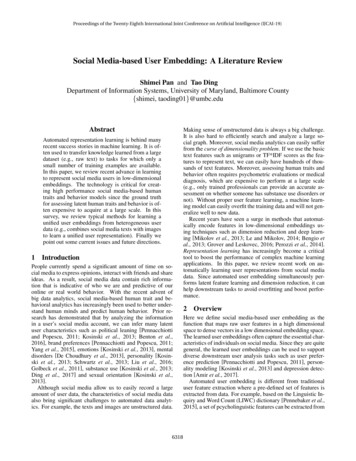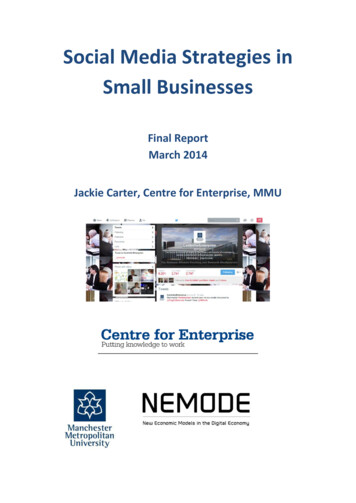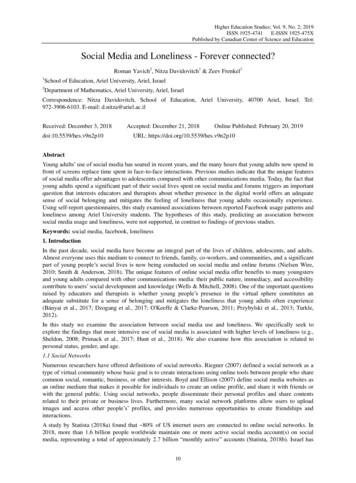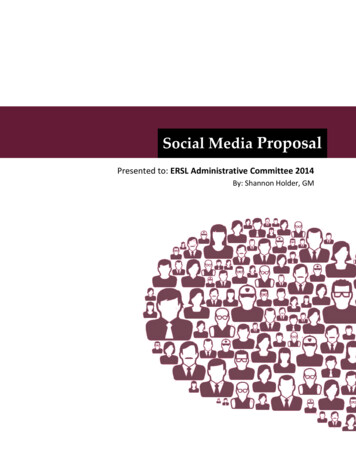
Transcription
Proceedings of the Twenty-Eighth International Joint Conference on Artificial Intelligence (IJCAI-19)Social Media-based User Embedding: A Literature ReviewShimei Pan and Tao DingDepartment of Information Systems, University of Maryland, Baltimore County{shimei, taoding01}@umbc.eduAbstractAutomated representation learning is behind manyrecent success stories in machine learning. It is often used to transfer knowledge learned from a largedataset (e.g., raw text) to tasks for which only asmall number of training examples are available.In this paper, we review recent advance in learningto represent social media users in low-dimensionalembeddings. The technology is critical for creating high performance social media-based humantraits and behavior models since the ground truthfor assessing latent human traits and behavior is often expensive to acquire at a large scale. In thissurvey, we review typical methods for learning aunified user embeddings from heterogeneous userdata (e.g., combines social media texts with imagesto learn a unified user representation). Finally wepoint out some current issues and future directions.1IntroductionPeople currently spend a significant amount of time on social media to express opinions, interact with friends and shareideas. As a result, social media data contain rich information that is indicative of who we are and predictive of ouronline or real world behavior. With the recent advent ofbig data analytics, social media-based human trait and behavioral analytics has increasingly been used to better understand human minds and predict human behavior. Prior research has demonstrated that by analyzing the informationin a user’s social media account, we can infer many latentuser characteristics such as political leaning [Pennacchiottiand Popescu, 2011; Kosinski et al., 2013; Benton et al.,2016], brand preferences [Pennacchiotti and Popescu, 2011;Yang et al., 2015], emotions [Kosinski et al., 2013], mentaldisorders [De Choudhury et al., 2013], personality [Kosinski et al., 2013; Schwartz et al., 2013; Liu et al., 2016;Golbeck et al., 2011], substance use [Kosinski et al., 2013;Ding et al., 2017] and sexual orientation [Kosinski et al.,2013].Although social media allow us to easily record a largeamount of user data, the characteristics of social media dataalso bring significant challenges to automated data analytics. For example, the texts and images are unstructured data.6318Making sense of unstructured data is always a big challenge.It is also hard to efficiently search and analyze a large social graph. Moreover, social media analytics can easily sufferfrom the curse of dimensionality problem. If we use the basictext features such as unigrams or TF*IDF scores as the features to represent text, we can easily have hundreds of thousands of text features. Moreover, assessing human traits andbehavior often requires psychometric evaluations or medicaldiagnosis, which are expensive to perform at a large scale(e.g., only trained professionals can provide an accurate assessment on whether someone has substance use disorders ornot). Without proper user feature learning, a machine learning model can easily overfit the training data and will not generalize well to new data.Recent years have seen a surge in methods that automatically encode features in low-dimensional embeddings using techniques such as dimension reduction and deep learning [Mikolov et al., 2013; Le and Mikolov, 2014; Bengio etal., 2013; Grover and Leskovec, 2016; Perozzi et al., 2014].Representation learning has increasingly become a criticaltool to boost the performance of complex machine learningapplications. In this paper, we review recent work on automatically learning user representations from social mediadata. Since automated user embedding simultaneously performs latent feature learning and dimension reduction, it canhelp downstream tasks to avoid overfitting and boost performance.2OverviewHere we define social media-based user embedding as thefunction that maps raw user features in a high dimensionalspace to dense vectors in a low dimensional embedding space.The learned user embeddings often capture the essential characteristics of individuals on social media. Since they are quitegeneral, the learned user embeddings can be used to supportdiverse downstream user analysis tasks such as user preference prediction [Pennacchiotti and Popescu, 2011], personality modeling [Kosinski et al., 2013] and depression detection [Amir et al., 2017].Automated user embedding is different from traditionaluser feature extraction where a pre-defined set of features isextracted from data. For example, based on the Linguistic Inquiry and Word Count (LIWC) dictionary [Pennebaker et al.,2015], a set of pcycholinguistic features can be extracted from
Proceedings of the Twenty-Eighth International Joint Conference on Artificial Intelligence (IJCAI-19)text. Similarly, a set of egocentric network features such asdegree, size and betweenness centrality can be extracted fromone’s social network. The main difference between user embedding and traditional user feature extraction is that in userembedding, the user features are not pre-defined. They arelatent features automatically learned from data.Figure 1 shows the typical architecture of a system thatemploys automated user embedding for personal traits andbehavior analysis. One or more types of user data are firstextracted from a social media account. For each type ofuser data such as text or image, a set of latent user features is learned automatically via single-view user embedding (e.g., text-based user embedding and image-based userembedding). The embeddings learned from different typesof user data (e.g., text embeddings and image embeddings)are combined to form a single unified user representation viamulti-view user embedding. The output of multi-view userembedding is then used in subsequent applications to predicthuman traits and behavior.Given the page limit, we define the scope of this surveyquite narrowly to include only embedding methods publishedwithin the last 10 years that have been used to learn user representations from social media data. Although very relevant,We exclude embedding methods that do not learn a representation of social media users. For example, we excludethe papers on learning word embeddings from social mediadata [Zeng et al., 2018]. Table 1 lists the papers included inour survey. We summarize each paper along six dimensions:Data Type, Single-view Embedding Method, Auxiliary Training Task, Multi-view Embedding Method, Target Task andSupervised Tuning.Among them, Data Type is used to indicate the types ofsocial media data used in each study. Here, text refers touser-generated text data (e.g., tweets or status update on Facebook); like refers to things/people a social media user likessuch as books, celebrities, music, movies, TV shows, photos and products; user profile includes demographic information (gender, age, occupation, relationship status etc.) andaggregated statistics (the number of friends, followers, followings etc.); image includes the profile and background photos as well as the images shared on social media; social network refers to social connections between different user accounts such as the friendship network on Facebook and thefollower/retweet network on Twitter.We also list the main methods used in Single-view andMulti-view user embedding. They typically employ unsupervised or self-supervised learning to automatically uncover thelatent structures/relations in the raw data. To employ selfsupervised user embedding, frequently an Auxiliary TrainingTask is employed for which the system can easily construct alarge number of training examples. We will explain the details of these methods later. Target task describes the downstream applications that make use of the learned embeddings.We also indicate whether the learned embeddings are furthertuned/adjusted so that they are optimized for the target tasks.In the following, We first present the typical Single-viewUser Embedding methods. Then we summarize the methodsthat combine multiple types of user information together toform a unified user representation.6319Figure 1: A typical system architecture3Single-View User EmbeddingSince most papers in table 1 learn user embedding from text,we focus on text-based user embeddings. We will also discussthe typical methods used in learning user embeddings fromsocial networks. Finally, we briefly describe how to learnuser embeddings from other types of social media data suchas likes and images.3.1Text-based User EmbeddingThe goal of text-based user embedding is to map a sequenceof social media posts by the same user into a vector representation which captures the essential content and linguisticstyle expressed in the text. Here, we focus on methods that donot require any human annotations such as traditional unsupervised dimension reduction methods (e.g., Latent DirichletAllocation and Single Value Decomposition) or the more recent neural network-based prediction methods.Latent Dirichlet Allocation (LDA)LDA is a generative graphical model that allows sets of observations to be explained by unobserved latent groups. Innatural language processing, LDA is frequently used to learna set of topics (latent themes) from a large number of documents. Several methods can be used to derive a user representation based on LDA results:(1)User-LDA which treatsall the posts from each user as a single document and trainsan LDA model to drive the topic distribution for this document. The per-document topic distribution is then used as therepresentation for this user. (2) Post-LDA which treats eachpost as a separate document and trains an LDA model to derive a topic distribution for each post. All the per-post topicdistribution vectors by the same user are aggregated (e.g., byaveraging them) to derive the representation of each user. According to [Ding et al., 2017], Post-LDA often learns better
Proceedings of the Twenty-Eighth International Joint Conference on Artificial Intelligence (IJCAI-19)PaperData TypeSingle-viewembeddingMethodAuxiliaryTraining TaskMulti-viewembeddingTaskTarget TaskTargettaskTuning[Pennacchiotti andPopescu, 2011]text,userprofileLDANAconcatenationpolitical learningNoNAethnicityuser preferenceage,gender, personalityNoNo[Kosinski et al.,2013]likeSVDNA[Schwartz et al.,2013]textLDANANArelationshipsubstance usereligionpolitical learningage,gender[Gao et al., 2014][Perozzi et al.,2014][Preoţiuc-Pietro etal., 2015]textnetworkSVDDeepWalkNAnode predictionNANApersonalityattributeuser interestsNoNotext, userprofileSVDNAconcatenationoccupationNo[Song et al., 2015][Hu et al., 2016][Song et al., 2016]texttexttextnetworkuser profiletextWord2VecLDALDALDAword NoNoYesPCANACCAtopic engagementNonetworkWord2vecPCAword predictionNAtextNAword predictionNAfriend recommendationage, genderpolitical learningsarcasm detectionYestextliketextDoc2vecDoc2vecWord2vecword predictionlike predictionword predictionCCAsubstance useNoNApolitical learningNo[Amir et al., 2017]textLDAWord2vecNAword NEgenderNo[Wang et al., 2017]user profilenetworkNMFNANANA[Ding2018a]likeSVD, LDANANAeducationpolitical learningcommunitydelay discountingNoNASNEgroup classificationNoNANAuser image popularityYes[Benton2016]etal.,[Wallace et al.,2016][Ding et al., 2017][Preoţiuc-Pietro etal., user MGloVeNANAGraphSagehateful p classificationNoDoc2vecNode2Vecword predictionnode predictionNAconcatenationlocationYes[Liao et al., 2018][Do et al., 2018]user profiletextnetworktimestampTable 1: Summary of user embedding methodsuser representations than User-LDA in downstream applications. This may be due to the fact that social media posts areoften short and thus each post may only have a single topic,6320which makes it easier for LDA to uncover meaningful topicsthan from one big document containing all the user posts.
Proceedings of the Twenty-Eighth International Joint Conference on Artificial Intelligence (IJCAI-19)Matrix RepresentationSince we can also use a matrix to represent user-word andword-word co-occurrences, matrix optimization techniquesare often used in learning user embeddings. If we use a sparsematrix to represent the relations between users and wordswhere each row represents a user and each column representsa unique term in the dataset, we can use matrix decomposition techniques such as Singular Value Decomposition (SVD)and Principle Component Analysis (PCA) to yield a set ofmore manageable and compact matrices that reveal hiddenrelations and structures in the data (e.g., correlation, orthogonality and sub-space relations).Recently, there is a surge of new text embedding methodsthat are designed to capture the semantics of words and documents. Except for GloVe ( Global Vectors for Word Representation), which uses matrix optimization to learn a generalrepresentation of words, most text embedding methods employ neural network-based methods. Since neural networkbased methods are supervised learning methods, to learn userembeddings, we often need an auxiliary training task forwhich a large number of training examples can be automatically constructed from raw social media data. We called thesemethods self-supervised machine learning.Word EmbeddingWord2Vec is a popular neural network-based method designed to learn dense vector representations for individualwords. The intuition behind the model is the DistributionalHypothesis, which states words that appear in the same context have similar meanings. There are two models for traininga representation of word: Continuous Bag of Word (CBOW)and Skip Gram (SG) model. CBOW predicts a target wordfrom one or more context words, while SG predicts one ormore context words from a target word. Thus, predictingwords in the neighborhood is the auxiliary task used to trainword embeddings. The models are frequently trained usingeither a hierarchical softmax function (HS) or negative sampling (NS) for efficiency. To learn user embeddings from social media posts, the word2vec model is first applied to learna vector representation for each word. Then a simple averageof all the word vectors by the same user is used to represent auser [Benton et al., 2016; Ding et al., 2017].GloVe is an unsupervised learning algorithm designed tolearn vector representations of words based on aggregatedglobal word-word co-occurrence statistics from a text corpus.GloVe employs a global log bi-linear regression model thatcombines the advantages of global matrix factorization withthat of local context window-based methods. GloVe has beenused in [Ding et al., 2017] to learn a dense vector for eachword. To summarize all the words authored by a user, we canuse a vector aggregation function such as average to combinethe vectors of all the words in a user’s posts.Document EmbeddingDoc2Vec is an extension of Word2Vec, which produces adense low dimensional feature vector for a document. Thereare two Doc2Vec models: Distributed Memory (DM) andDistributed Bag-of-Words (DBOW). Given a sequence of tokens in a document, DM can simultaneously learn a vectorrepresentation for each individual word token and a vector6321for the entire document. In DM, each sequence of words (e.g.a document) is mapped to a sequence vector (e.g., documentvector) and each word is mapped to a unique word vector.The document vector and one or more word vectors are aggregated to predict a target word in the context. DBOW learns aglobal vector to predict tokens randomly sampled from a document. Unlike DM, DBOW only learns a vector for the entiredocument. It does not use a local context window since thewords for prediction are randomly sampled from the entiredocument.There are two typical methods for learning a user embedding from doc2vec results: (1) User-D2V which combines allthe posts by the same user in one document and trains a document vector to represent the user. (2) Post-D2V which treatseach post as a document and train a doc2vec model to learna vector for each post. To derive a user embedding, all thepost vectors from the same person can be aggregated using“average”.Recurrent Neural Networks (RNN)The text embedding methods described above ignore the temporal order of the words in a post and of the posts in a useraccount. Since the order of text contains important information, to capture the sequential relations between wordsand posts, Recurrent Neural Network (RNN) models such asLong Short-Term Memory (LSTM) can be used [Zhang et al.,2018a]. The input to an LSTM is a sequence of word embeddings and the output of an LSTM is a sequence of hiddenstates, which are the input to downstream applications. Similar to word2vec, a language model-based auxiliary task isused to train a LSTM model on raw texts.Among all the text embedding methods we discussed,some employ prediction-based technologies (e.g., Word2Vec,Doc2Vec and LSTM), others use count-based methods (e.g.,PCA, SVD, LDA and GloVe). There are some empiricalevidence indicating that prediction-based methods may havesome advantage over count-based methods in feature learning [Baroni et al., 2014]. Among all the text embeddingmethods we discussed, only LDA generates embeddings thatare somewhat interpretable.3.2Social Network-based User EmbeddingThe objective of social network-based user embedding is tomap very large social networks into low-dimensional embeddings that preserve local and global topological similarity.These methods focus primarily on learning a user representation that captures essential social structures and relations ofa user. The three most widely used network embedding methods are DeepWalk [Perozzi et al., 2014], Node2vec [Groverand Leskovec, 2016] and Matrix Factorization.DeepWalk learns latent representations of vertices in a network from truncated random walks. It first generates shortrandom walks. Each random walk S v1 , v2 , ., vl is treatedas a sequence of words in a sentence. DeepWalk then employs the SkipGram model (SG) in word2vec to learn the latent representation of a vertex. The learned embeddings canbe used in many applications such as predicting user interestsand anomaly detection [Perozzi et al., 2014].Node2Vec is a modification of DeepWalk which employs
Proceedings of the Twenty-Eighth International Joint Conference on Artificial Intelligence (IJCAI-19)a biased random walk to interpolate between Breadth-firstSampling (BFS) and Depth-first Sampling (DFS). With biased random walks, Node2vec can better preserve boththe second-order and high-order proximity [Grover andLeskovec, 2016]. Given the set of neighboring vertices generated by a biased random walk, Node2Vec learns the vertexrepresentation using the SkipGram model (SG). The learnedembedding has been used to characterize a Twitter user’s social network structure [Do et al., 2018] and predict user interests [Grover and Leskovec, 2016].Non-Negative Matrix Factorization (NMF) is a matrix decomposition method with the additional constraint that all theentries in all the matrices have only positive values. Theconnections between network vertices are represented in anadjacency matrix. Non-negative matrix factorization is usedto obtain a low-dimensional embedding of the original matrix. NMF was used in [Wang et al., 2017] to learn anetwork-based user embedding that preserves both the firstand second-order proximity.3.3Other Single-View User Embedding MethodsIn addition to texts and social networks, it is also possible tolearn user embeddings from other types of social media datasuch as likes and images. For example, User Like Embedding was used in [Kosinski et al., 2013; Ding et al., 2018a]for personality and delay discounting prediction. Many textbased user embedding methods are also applicable here. Forexample, SVD was used in [Kosinski et al., 2013]; LDA,GloVe, Word2Vec, Doc2vec were used in [Ding et al., 2017;2018a]. In addition, AutoEncoder (AE) can be used in learning like embeddings. AE is a neural network-based featurelearning method [Hinton and Salakhutdinov, 2006]. It learnsan identity function so that the output is as close to the input as possible. Although an identity function seems a trivialfunction to learn, by placing additional constraints (e.g,, tomake the number of neurons in the hidden layer much smallerthan that of the input), we can still force the system to uncoverlatent structures in the data. Finally, Image-based User Embedding can be obtained by extracting low-level latent imagefeatures from pre-tained deep neural network models such asVGGNet [Simonyan and Zisserman, 2014].4Multi-View User EmbeddingTo obtain a comprehensive and unified user representationbased on all the social media data available, we need to combine user features from different views together. In addition to simply concatenating features extracted from differentviews, we can also apply machine learning algorithms to systematically fuse them. We categorize these fusion methodsinto two types: (a) general fusion methods (b) customizedfusion methods. General fusion methods can be applied todiverse types of embedding vectors such as text and imageembedding or text and like embedding . In contrast, customized fusion methods are specifically designed to combinecertain types of user data together. For example, ANRL is amethod specifically designed to fuse user attributes and network topology together [Zhang et al., 2018b].63224.1General Fusion MethodsFirst, we introduce two widely used general fusion methods.Canonical Correlation Analysis (CCA) CCA is a statistical method that explores the relationships between two multivariate sets of variables (vectors) [Hardoon et al., 2004].Given two feature vectors, CCA tries to find a linear transformation of each feature vector so that they are maximallycorrelated. CCA has been used in [Sharma et al., 2012;Ding et al., 2017] for multi-view fusion.Deep Canonical Correlation Analysis (DCCA) DCCA isa non-linear extension of CCA, aiming to learn highly correlated deep architectures [Andrew et al., 2013]. The intuitionis to find a maximally correlated representation of two feature vectors by passing them through multiple stacked layersof nonlinear transformation. Typically, there are three stepsin training DCCA: (1) using a denoising autoencoder to pretrain each single view; (2) computing the gradient of the correlation of top-level representation; (3) tuning parameters using back propagation to optimize the total correlation.The features learned from multiple views are often moreinformative than those from a single view. Comparing withsingle-view user embedding, multi-view embedding achievedsignificantly better performance in predicting demographics[Benton et al., 2016], politic leaning [Benton et al., 2016]and substance use [Ding et al., 2017].4.2Customized Fusion MethodsSeveral studies in our survey employ algorithms that arespecifically designed to combine certain types of data. Forexample, [Zhang et al., 2017] proposed a new algorithmcalled User Profile Preserving Social Network Embedding(UPPSNE), which combines user profiles and social network structures to learn a joint vector representation of auser. Similarly, Attributed Network Representation Learning (ANRL) [Zhang et al., 2018a] employed a deep neural network to incorporate information from both networkstructure and node attributes. It learns a single user representation that jointly optimizes AutoEncoder loss, SkipGram loss and Neighbour Prediction Loss. [Liao et al., 2018]proposed a Social Network Embedding framework (SNE),which learns a combined representations for social mediausers by preserving both structural proximity and attributeproximity. [Ribeiro et al., 2018] creates embeddings for eachnode with word embeddings learn from text using GloVe andthe activity/network-centrality attributes associated with eachuser. So far, most of the customized fusion methods are designed to fuse network topology with additional node information (e.g., user profiles).5Embedding Fine Tuning Using Target TasksIn many cases, the learned user embeddings are simply usedas the input to a target task. It is also possible that the learneduser embeddings can be further refined to better support thetarget tasks with supervised learning. For example, in [Miuraet al., 2017], the authors propose an attention-based neuralnetwork model to predict geo-location. It simultaneouslylearns text, network and metadata embeddings in supervisedfine turning. In [Song et al., 2016], the authors collected
Proceedings of the Twenty-Eighth International Joint Conference on Artificial Intelligence (IJCAI-19)multi-view user data from different platforms (e.g., Twitter,Facebook, LinkedIn of the same user) and predicted volunteerism based on user attributes and network features. Then,they combine these two sets of features in supervised finetuning to enhance the final prediction. [Farnadi et al., 2018]learned a hybrid user profile which is a shared user representation learned from three data sources. They were combinedat decision level to predict multiple user attributes (e.g., age,gender and personality).6DiscussionLarge-scale social media-based user trait and behavior analysis is an emerging multidisciplinary field with the potential totransform human trait and behavior analysis from controlledsmall scale experiments to large scale studies of natural human behavior in an open environment. Although raw social media data are relatively easy to obtain, it is expensiveto acquire the ground truth data at a large scale. The proposed unsupervised/self-supervised user embedding methodscan alleviate the “small data” problem by transferring knowledge learned from raw social media data to a new target task.This step is very important for many human trait and behavior analysis applications. According to [Benton et al., 2016;Preoţiuc-Pietro et al., 2015], machine learning models that incorporate unsupervised/self-supervised user embedding significantly outperform the baselines that do not employ useembedding. Based on the survey, we have also identified afew major issues in the current social media analysis research.6.1InterpretabilityAlthough systems employing user embeddings significantlyoutperform baselines in terms of prediction accuracy, thesesystems also suffer from one significant drawback: low interpretability. Since user embedding features are latent featuresautomatically uncovered by the system, it is often difficultfor humans to understand the meaning of these features. Thismay significantly impact our ability to gain insight into thesebehavioral models. So far, there have not been much work focusing on learning user representations that are both effectiveand interpretable.6.2Ethical IssuesDue to the privacy concerns in accessing user data on socialmedia and the sensitive nature of the inferred user characteristics, if not careful, there could be significant privacy consequences and ethical implications. So far, most of the studiesin our survey focused primarily on optimizing system performance. There have not been sufficient discussion on ethicalconcerns when conducting research in this field.7Future DirectionsEach of the main issues we identified above also presents agood opportunity for future work.7.1Interpretable User Representation Learningwe need more research on learning high-performance userrepresentations that are also interpretable. Some preliminarywork has conducted in this area. In [Ding et al., 2018b], a6323knowledge distillation framework was proposed to train behavior models that are both highly accurate and interpretable.Developing causal models for both inference and interpretation is another potential new direction.7.2Ethical Research on Data-driven BehaviorAnalysisEthical issues are complex, multifaceted and resist simple solutions. In addition to privacy concerns in data collection,researchers working on social media-based human trait andbehavior analysis also face other ethical challenges includinginformed consent, traceability and working with children andyoung people. There is an urgent need for the research community to decide an ethical framework to guide researchers tonavigate obstacles, gain trust and still allow them to capturesalient behavioral and social phenomena. Recently there isa surge of interests and research on fair data-driven decisionmaking. As a researcher, we also need to be aware of the potential impact of social media analytics on the well-being ofindividuals and our society.We have also identified a few possible research directionsto improve the state of the art user embedding techniques.7.3Temporal User Embeddingsince most social media data are collected over a long periodof time and associated with time stamps, it is an ideal datasource for longitudinal data analysis. Also, for many medicaland public health applications, analyzing behavioral changesover time is critical to understanding one’s decision makingprocess. Although Recurrent Neural Networks such as LSTMcan capture some sequential patterns, they totally ignore thetime stamp associated with each event. More work on learning user embedding from time is needed.7.4User Embedding with Multi-task LearningSince individual traits and behavior are highly correlated,building a prediction model that simultaneous infer multiplecorrelated traits and behavior should yield better performancethan predicting each trait/behavior separately. Most existing studies only predict one user attribute/behavior at a time.More research is needed to jointly train and predict multipleuser attributes together for better performance.7.5Cross-platform FusionIt is also common for a user to have multiple accounts ondifferent social media platforms. Recentl
social networks. Finally, we briey describe how to learn user embeddings from other types of social media data such as likes and images. 3.1 Text-based User Embedding The goal of text-based user embedding is to map a sequence of social media posts by the same user into a vector repre-sent










